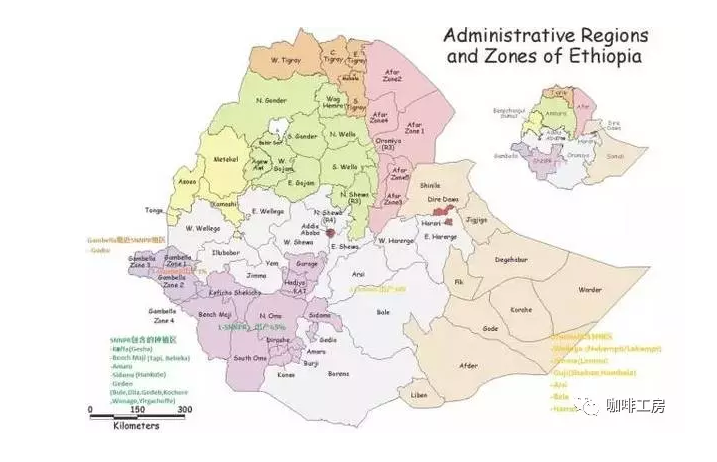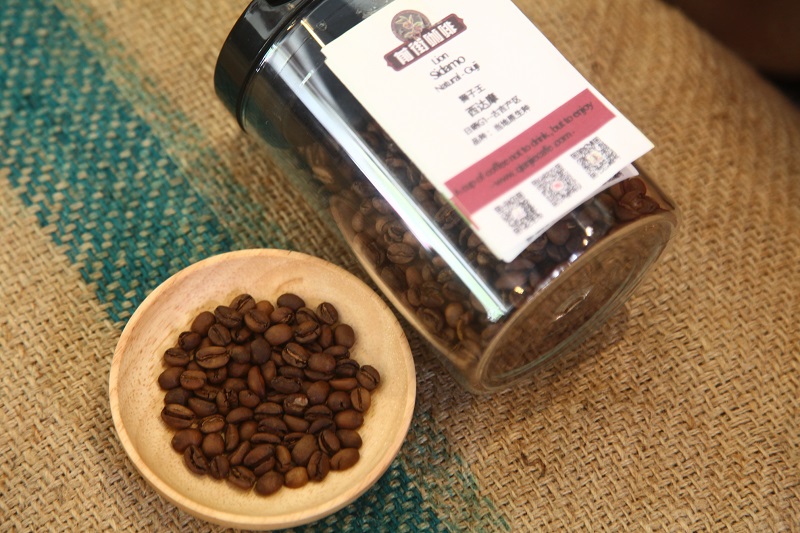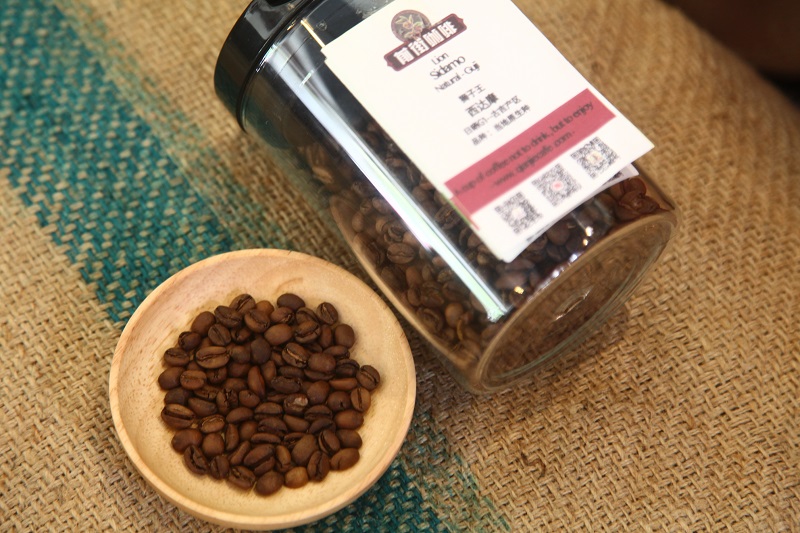Knowledge of Ethiopian producing areas, Lion King sun introduction of Guji producing areas in Sidamo, Ethiopia
Ethiopia
Name: Ethiopia
Location: East Africa
Capital: Addis Ababa
Religion: Christian majority
Language: Amharic
Time zone: GMT+3
Measurement: Metric
Currency: Birr (1$≈20 birr)
Agricultural products (exports): coffee, flowers and sesame are the main cash crops exported
Ports: Djibouti port (Djibouti, now the main export port)
Annual average temperature: 15-20c in highland, 25-30c in lowland;
Average annual rainfall: 1000-2000 mm
Soil: 50% volcanic-25% sedimentary-25% other
James Elford's Blog
Ethiopia is a country full of magic, and what we call undrunk Arabica coffee originated here.
The historical evidence of coffee recorded in Ethiopia can be traced back to the 4th-5th century AD. At that time, due to inter-ethnic wars, coffee spread to Yemen in the Arabian Peninsula with people's wars and migrations. Later, with the rise of the Ottoman Empire and the spread of Islam, various reasons began to exist in Europe and the coffee shop culture gradually formed. Later, coffee began to be grown in Central America, India and Indonesia in Asia began to grow coffee on a large scale. It took hundreds of years for us to get to the third wave of specialty coffee.
Ethiopian coffee originated and spread from Makira virgin forest
Administrative divisions of Ethiopia
Ethiopia is a federal republic and since 1995 administrative regions have been divided into a new system.
9 autonomous regions
● 2 municipalities
The autonomous region is further divided into Zone areas, Woreda County and Kebele Township.
Note: Most of our common coffee names are Woreda County or Kebele Township Level 1.
Ethiopia administrative division data from Wikipedia
Climate in Ethiopia
Ethiopia's climate experience is polarized, half wet rain forest, half dry desert Gobi
This is also the reason why coffee cultivation is mainly distributed in the southern tribal states SNNPR and Oromia.
Climate distribution of Ethiopia
Source of annual precipitation worldclim
Ethiopia's main rainfall season is 6, 7 and 8 months, and the annual precipitation in the main coffee growing area is 1000-2000 mm.
Figure Annual Average Temperature Source Worldclim
The coldest months in Ethiopia are December and January, and the hottest months are March, April and May.
The average annual temperature in the main growing area of coffee is between 15 and 30 degrees Celsius
Coffee cultivation in Ethiopia
Due to the change of administrative division in Ethiopia around 1995, the biggest impact on coffee region is that the original Sidamo Province is divided into the new Sidama Sidama (a small part of the original), and most of it is included in Oromia State; Moreover, Yejia Shefi, which originally belonged to West Dharma Province, is now classified into the new Gedeo District. There will be a mixture of new and old regional names in the Ethiopian coffee products circulating in the market. Here, we take the new regional division as the benchmark and combine the administrative regions to understand the coffee planting map of Lower Ethiopia.
Coffee cultivation in Ethiopia is classified according to scale and mode (Note 1)
Forest coffee (8-10%), coffee trees coexist with other crops in the original forest, without any artificial care, farmers will regularly pick coffee fruit
● Semi-forest coffee (30-35%), coffee tree planting area is located around the forest and farmers 'living area, coffee tree and forest coffee are the same natural production varieties, farmers will manage coffee tree planting area and plant other cash crops.
Garden coffee (50-55%), coffee trees are planted around farmers 'living areas, and most of them are coffee planted by farmers themselves.
● plantation coffee (5-6%), large private growers with more processing facilities and production capacity

Lion King Sunburn Guji Production Area, Sidama Province, Ethiopia
Sidamo coffee has a wide variety of flavors, as different soil compositions, regional microclimates, and numerous native coffee varieties create distinct differences and characteristics in the coffee produced in each town area. Sidama is located in southern Ethiopia. The industry here is dominated by agriculture, with coffee-growing areas located around the Great Rift Valley. Sidamo coffee has a wide variety of flavors, as different soil compositions, regional microclimates, and numerous native coffee varieties create distinct differences and characteristics in the coffee produced in each town area. Sidama is located in southern Ethiopia. The industry here is dominated by agriculture, with coffee-growing areas located around the Great Rift Valley.
Guji is located southeast of Gedeo, where Sidama is produced, at an altitude of 2100 meters, but it is higher than Yega, with a maximum altitude of more than 2600 meters. Guji coffee tends to be blueberry sweet with lemon notes, rich fruity aromas, peach dried honey notes with surprising bright acidity and full berry fruit aromas
1. After picking, the beans have not been specially selected and treated, and the uneven quality and maturity are mixed together. The process is relatively rough, so the quality of coffee beans is unstable and easy to have defective beans.
2. Coffee farmers usually find a vacant lot near their homes to deal with, so there are often a lot of impurities or dirty things on the ground, and coffee is easily contaminated with impurities.
The improved solarization method aims at improving the two shortcomings of the traditional method:
1. Only fully ripe dark red coffee cherries are picked at the time of picking. Before being exposed to sunlight, the beans are screened for defects at the processing plant to make the beans look more average in size and maturity.
2. Then, use a raised wooden frame or whole trellis for sunning, which will avoid the risk of the beans getting contaminated by the smell on the ground. During the exposure process, the beans should be carefully cared for so that the coffee beans can be evenly exposed to moisture; every three to five days, coffee workers will manually screen out the defective moldy beans. So by the time the sun is done and the beans come into the field without the skin and flesh, a piece of sunburned, bright red coffee cherry is already at a very blemish grade. After harvesting, coffee beans must be immediately processed, otherwise they will start to ferment and cause coffee beans to produce odors. There are two methods of treatment,"solarization" and "washing", which will cause different flavors. The beans of solarization method have complete natural mellow flavor, gentle aroma and more colloid; washing method has good mellow flavor, high aroma and lively acidity.
[Sunlight Sidamo]: The bean body is smaller than Longberry, green with yellow, in the Sidamo sun drying field, coffee is placed in the hemp net rack, workers take turns in the sun exposure, manually stir coffee, Sunlight Sidamo is usually marked with G4 export mostly, washed Sidamo because the processing process is more perfect than the sun, so most of the G2 grade exports more.
[Washed Sidama]: Coffee green is slightly gray, some places are coarse and some places are fine, acidity is soft and strong, alcohol is appropriate, sweet and spicy, it is one of the courtyard coffee in the southern highlands of Ethiopia. It differs from African coffee in that Sidamo has a clear acidity, a smooth taste and a delicate floral aroma.
The Sun Sidama Lion King! 15 g beans, steamed in 90° water for 30 seconds, 1:15 powder-water ratio

Important Notice :
前街咖啡 FrontStreet Coffee has moved to new addredd:
FrontStreet Coffee Address: 315,Donghua East Road,GuangZhou
Tel:020 38364473
- Prev

Flavor and taste characteristics of Sidamo Sun Lion King Coffee beans introduction to Esseguji Coffee producing area
The flavor of coffee in Sidamo, the Guji producing area of Sidamo, Ethiopia, is very diverse, because of the different soil composition, regional microclimate and countless native coffee varieties, the coffee produced in each town area has obvious differences and characteristics. Sidamo production area (Sidama)
- Next

The introduction of the nine boutique producing areas in Ethiopia, the parameters of the Lion King hand Chong in Xidamo
Ethiopian name: Ethiopia location: East African Capital: Adis Abba Addis Ababa Religion: Christian main language: Amharic time Zone: GMT+3 Metrology: metric (Metric) currency: bill Birr (1 $20 birr) Agricultural products (export): coffee, flowers, sesame are the main cash crops export port: Djibouti, now
Related
- Detailed explanation of Jadeite planting Land in Panamanian Jadeite Manor introduction to the grading system of Jadeite competitive bidding, Red bid, Green bid and Rose Summer
- Story of Coffee planting in Brenka region of Costa Rica Stonehenge Manor anaerobic heavy honey treatment of flavor mouth
- What's on the barrel of Blue Mountain Coffee beans?
- Can American coffee also pull flowers? How to use hot American style to pull out a good-looking pattern?
- Can you make a cold extract with coffee beans? What is the right proportion for cold-extracted coffee formula?
- Indonesian PWN Gold Mandrine Coffee Origin Features Flavor How to Chong? Mandolin coffee is American.
- A brief introduction to the flavor characteristics of Brazilian yellow bourbon coffee beans
- What is the effect of different water quality on the flavor of cold-extracted coffee? What kind of water is best for brewing coffee?
- Why do you think of Rose Summer whenever you mention Panamanian coffee?
- Introduction to the characteristics of authentic blue mountain coffee bean producing areas? What is the CIB Coffee Authority in Jamaica?

